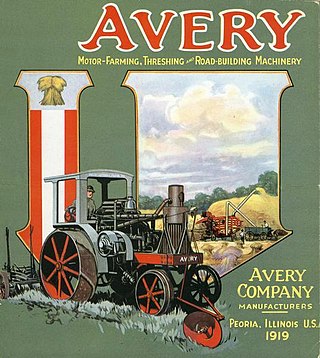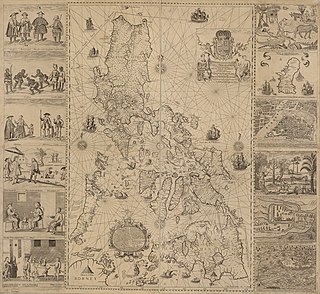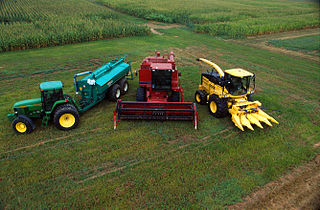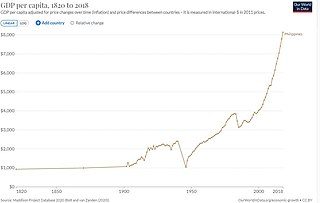Related Research Articles

A threshing machine or a thresher is a piece of farm equipment that separates grain seed from the stalks and husks. It does so by beating the plant to make the seeds fall out. Before such machines were developed, threshing was done by hand with flails: such hand threshing was very laborious and time-consuming, taking about one-quarter of agricultural labour by the 18th century. Mechanization of this process removed a substantial amount of drudgery from farm labour. The first threshing machine was invented circa 1786 by the Scottish engineer Andrew Meikle, and the subsequent adoption of such machines was one of the earlier examples of the mechanization of agriculture. During the 19th century, threshers and mechanical reapers and reaper-binders gradually became widespread and made grain production much less laborious.

In agriculture, a terrace is a piece of sloped plane that has been cut into a series of successively receding flat surfaces or platforms, which resemble steps, for the purposes of more effective farming. This type of landscaping is therefore called terracing. Graduated terrace steps are commonly used to farm on hilly or mountainous terrain. Terraced fields decrease both erosion and surface runoff, and may be used to support growing crops that require irrigation, such as rice. The Rice Terraces of the Philippine Cordilleras have been designated as a UNESCO World Heritage Site because of the significance of this technique.

A cultivator is a piece of agricultural equipment used for secondary tillage. One sense of the name refers to frames with teeth that pierce the soil as they are dragged through it linearly. Another sense of the name also refers to machines that use the rotary motion of disks or teeth to accomplish a similar result, such as a rotary tiller.

The Avery Company, founded by Robert Hanneman Avery, was an American farm tractor manufacturer famed for its undermounted engine which resembled a railroad engine more than a conventional farm steam engine. Avery founded the farm implement business after the Civil War. His company built a large line of products, including steam engines, beginning in 1891. The company started with a return flue design and later adapted the undermount style, including a bulldog design on the smokebox door. Their design was well received by farmers in central Illinois. They expanded their market nationwide and overseas until the 1920s, when they failed to innovate and the company faltered. They manufactured trucks for a period of time, and then automobiles. until they finally succumbed to an agricultural crisis and the Depression.

A sprayer is a device used to spray a liquid, where sprayers are commonly used for projection of water, weed killers, crop performance materials, pest maintenance chemicals, as well as manufacturing and production line ingredients. In agriculture, a sprayer is a piece of equipment that is used to apply herbicides, pesticides, and fertilizers on agricultural crops. Sprayers range in size from man-portable units to trailed sprayers that are connected to a tractor, to self-propelled units similar to tractors with boom mounts of 4–30 feet (1.2–9.1 m) up to 60–151 feet (18–46 m) in length depending on engineering design for tractor and land size.

Science and technology in the Philippines describes scientific and technological progress made by the Philippines and analyses related policy issues. The main agency responsible for managing science and technology (S&T) is the Department of Science and Technology (DOST). There are also sectoral councils for Forestry, Agriculture and Aquaculture, the Metal Industry, Nuclear Research, Food and Nutrition, Health, Meteorology, Volcanology and Seismology.

Two-wheel tractor or walking tractor are generic terms understood in the US and in parts of Europe to represent a single-axle tractor, which is a tractor with one axle, self-powered and self-propelled, which can pull and power various farm implements such as a trailer, cultivator or harrow, a plough, or various seeders and harvesters. The operator usually walks behind it or rides the implement being towed. Similar terms are mistakenly applied to the household rotary tiller or power tiller; although these may be wheeled and/or self-propelled, they are not tailored for towing implements. A two-wheeled tractor specializes in pulling any of numerous types of implements, whereas rotary tillers specialize in soil tillage with their dedicated digging tools. This article concerns two-wheeled tractors as distinguished from such tillers.

Bayugan National Comprehensive High School (BNCHS) (Filipino:PambansangMataas na Paaralang Komprehinsibo ng Bayugan), popularly known as Compre, is a public, coeducational, comprehensive high school in Bayugan, Agusan del Sur, Philippines.

The cultural achievements of pre-colonial Philippines include those covered by the prehistory and the early history (900–1521) of the Philippine archipelago's inhabitants, the pre-colonial forebears of today's Filipino people. Among the cultural achievements of the native people's belief systems, and culture in general, that are notable in many ethnic societies, range from agriculture, societal and environmental concepts, spiritual beliefs, up to advances in technology, science, and the arts.
Alexis T. Belonio is a professor, engineer, scientist, innovator and inventor from the Philippines. He was "the first Filipino to receive the Rolex Award for Enterprise" in 2008 for his invention of a low-cost and environment friendly rice husk stove. Belonio was included by the Rolex watchmaking company on its list of 10 model innovators in November 2008. He serves as the incumbent chair of the Agricultural Engineering and Environmental Management department of Central Philippine University.

Agricultural machinery relates to the mechanical structures and devices used in farming or other agriculture. There are many types of such equipment, from hand tools and power tools to tractors and the farm implements that they tow or operate. Machinery is used in both organic and nonorganic farming. Especially since the advent of mechanised agriculture, agricultural machinery is an indispensable part of how the world is fed.

The International Federation of Inventors' Associations (IFIA) is a non-profit, nongovernmental organization founded in London under the supervision of the United Nations, on July 11, 1968, by inventor's associations of Denmark, Finland, Germany, Great Britain, Norway, Sweden and Switzerland.

The economic history of the Philippines chronicles the long history of economic policies in the nation over the years.

The Central Mechanical Engineering Research Institute is a public engineering research and development institution in Durgapur, West Bengal, India. It is a constituent laboratory of the Indian Council of Scientific and Industrial Research (CSIR). This institute is the only national level research institute in the field of mechanical engineering in India.
Threshing is a key part of agriculture that involves removing the seeds or grain from plants from the plant stalk. In the case of small farms, threshing is done by beating or crushing the grain by hand or foot, and requires a large amount of hard physical labour. A simple thresher with a crank can be used to make this work much easier for the farmer. In most cases it takes two people to work these: one person to turn the crank and the other to feed the grain through the machine. These threshers can be built using simple materials and can improve the efficiency of grain threshing. They can also be built with pedals, or be attached to a bicycle, so that the person operating it can simply pedal to reduce the work even more and make threshing faster.
C. P. Sadashivaiah was an Indian freedom fighter who later became an industrialist, philanthropist and inventor. He has to his credit several designs of agricultural equipments and implements, some of which he himself designed, while many he improved.

The agricultural machinery industry or agricultural engineering industry is the part of the industry, that produces and maintain tractors, agricultural machinery and agricultural implements used in farming or other agriculture. This branch is considered to be part of the machinery industry.
Republic Act No. 8293, otherwise known as The Intellectual Property Code of the Philippines lays down the rules and regulations that grant, and enforce patents in the Philippines. Patents may be granted to technical solutions such as an inventions, machines, devices, processes, or an improvement of any of the foregoing. The technical solution must be novel, innovative, and industrially useful. In order for a technical solution to be granted a patent, the inventor must file an application to the Bureau of Patents, which will examine, and in some cases, grant its approval. The law is designed as to foster domestic creativity, to attract foreign investors, and to motivate inventors to release their products for public access.

The Central Philippine University College of Agriculture, Resources and Environmental Sciences, also referred to as CPU CARES or CPU Agriculture, is one of the academic units of Central Philippine University, a private university in Iloilo City, Philippines.
References
- ↑ "Villaruz". www.csupomona.edu. Archived from the original on 24 January 2003. Retrieved 22 May 2022.
- ↑ Women Invent:Two Centuries of Discoveries That Have Shaped Our World by Susan Mary Casey (Chicago review Press, 1997) pp. 2-3. Patently Female, Ethlie Ann Vare and Greg Ptacek, (John Wiley and Sons 2002) p. 131.
- 1 2 3 "Women Inventors - Philippines Archived copy" (PDF). Archived from the original (PDF) on 2014-12-20. Retrieved 2014-12-14.
- ↑ "WIPO - World Intellectual Property Organization". Wipo.int. 2019-10-09. Retrieved 2019-11-19.
- ↑ "Archived copy" (PDF). Archived from the original (PDF) on 2014-12-14. Retrieved 2014-12-14.
{{cite web}}: CS1 maint: archived copy as title (link)